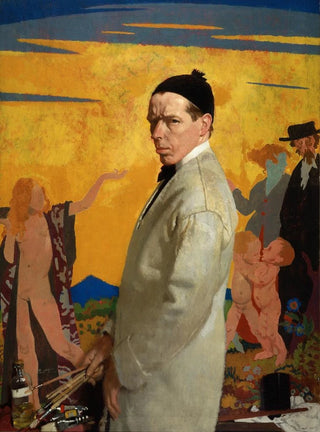Art print | Self-portrait - Sir William Orpen


View from behind

Frame (optional)
Sir William Orpen's self-portrait is a work that invites deep contemplation. This painting, created by one of the most remarkable artists of the early 20th century, is not merely a simple representation of the artist. It is an intimate exploration of his identity and inner world. Orpen, by capturing his own face, offers us a reflection on the duality of the artist, oscillating between observation and self-analysis. Through this masterpiece, the viewer is invited on an emotional journey, where each brushstroke seems charged with meaning and humanity.
Style and uniqueness of the work
Sir William Orpen's self-portrait stands out for its unique style, blending realism and expressionism. The color palette chosen by the artist, both rich and nuanced, creates an atmosphere that swings between melancholy and psychological depth. Orpen excels in depicting textures, whether in the skin, clothing, or surrounding elements. His gaze, both piercing and introspective, immediately draws attention, inviting the viewer to question the thoughts and emotions that inhabit him. The composition, carefully thought out, highlights not only the artist's face but also the context in which he evolves, thus emphasizing the importance of the environment in shaping identity. This work is a true artistic statement, a mirror reflecting the complexities of the human condition.
The artist and his influence
Sir William Orpen is recognized not only for his exceptional talent but also for his prominent role in the art world of the early 20th century. Trained at the Royal Academy of Arts, he established himself as a leading portraitist, attracting the attention of the elites of his time. His innovative approach to portrait painting, combined with a keen sensitivity to psychological nuances, influenced many contemporary and future artists. Orpen was able to capture the essence of his subjects, going beyond mere physical representation to explore the emotional layers that define them. His legacy endures through generations, and his self-portrait

Matte finish

View from behind

Frame (optional)
Sir William Orpen's self-portrait is a work that invites deep contemplation. This painting, created by one of the most remarkable artists of the early 20th century, is not merely a simple representation of the artist. It is an intimate exploration of his identity and inner world. Orpen, by capturing his own face, offers us a reflection on the duality of the artist, oscillating between observation and self-analysis. Through this masterpiece, the viewer is invited on an emotional journey, where each brushstroke seems charged with meaning and humanity.
Style and uniqueness of the work
Sir William Orpen's self-portrait stands out for its unique style, blending realism and expressionism. The color palette chosen by the artist, both rich and nuanced, creates an atmosphere that swings between melancholy and psychological depth. Orpen excels in depicting textures, whether in the skin, clothing, or surrounding elements. His gaze, both piercing and introspective, immediately draws attention, inviting the viewer to question the thoughts and emotions that inhabit him. The composition, carefully thought out, highlights not only the artist's face but also the context in which he evolves, thus emphasizing the importance of the environment in shaping identity. This work is a true artistic statement, a mirror reflecting the complexities of the human condition.
The artist and his influence
Sir William Orpen is recognized not only for his exceptional talent but also for his prominent role in the art world of the early 20th century. Trained at the Royal Academy of Arts, he established himself as a leading portraitist, attracting the attention of the elites of his time. His innovative approach to portrait painting, combined with a keen sensitivity to psychological nuances, influenced many contemporary and future artists. Orpen was able to capture the essence of his subjects, going beyond mere physical representation to explore the emotional layers that define them. His legacy endures through generations, and his self-portrait






